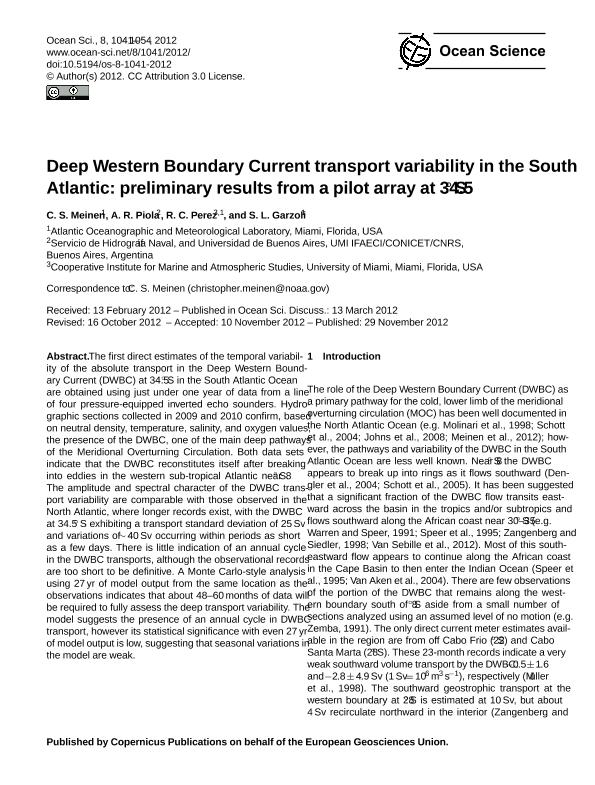Mostrar el registro sencillo del ítem
dc.contributor.author
Meinen, C. S.
dc.contributor.author
Piola, Alberto Ricardo

dc.contributor.author
Perez, R. C.
dc.contributor.author
Garzoli, S. L.
dc.date.available
2023-05-22T13:07:20Z
dc.date.issued
2012-11
dc.identifier.citation
Meinen, C. S.; Piola, Alberto Ricardo; Perez, R. C.; Garzoli, S. L.; Deep Western Boundary Current transport variability in the South Atlantic: Preliminary results from a pilot array at 34.5° S; Copernicus Publications; Ocean Science (os); 8; 6; 11-2012; 1041-1054
dc.identifier.issn
1812-0784
dc.identifier.uri
http://hdl.handle.net/11336/198339
dc.description.abstract
The first direct estimates of the temporal variability of the absolute transport in the Deep Western Boundary Current (DWBC) at 34.5° S in the South Atlantic Ocean are obtained using just under one year of data from a line of four pressure-equipped inverted echo sounders. Hydrographic sections collected in 2009 and 2010 confirm, based on neutral density, temperature, salinity, and oxygen values, the presence of the DWBC, one of the main deep pathways of the Meridional Overturning Circulation. Both data sets indicate that the DWBC reconstitutes itself after breaking into eddies in the western sub-tropical Atlantic near 8° S. The amplitude and spectral character of the DWBC transport variability are comparable with those observed in the North Atlantic, where longer records exist, with the DWBC at 34.5° S exhibiting a transport standard deviation of 25 Sv and variations of ∼ 40 Sv occurring within periods as short as a few days. There is little indication of an annual cycle in the DWBC transports, although the observational records are too short to be definitive. A Monte Carlo-style analysis using 27 yr of model output from the same location as the observations indicates that about 48-60 months of data will be required to fully assess the deep transport variability. The model suggests the presence of an annual cycle in DWBC transport, however its statistical significance with even 27 yr of model output is low, suggesting that seasonal variations in the model are weak.
dc.format
application/pdf
dc.language.iso
eng
dc.publisher
Copernicus Publications

dc.rights
info:eu-repo/semantics/openAccess
dc.rights.uri
https://creativecommons.org/licenses/by/2.5/ar/
dc.subject
Deep Western Boundary Currents
dc.subject
Southwest Atlantic
dc.subject
Meridional Overturning Circulation
dc.subject.classification
Oceanografía, Hidrología, Recursos Hídricos

dc.subject.classification
Ciencias de la Tierra y relacionadas con el Medio Ambiente

dc.subject.classification
CIENCIAS NATURALES Y EXACTAS

dc.title
Deep Western Boundary Current transport variability in the South Atlantic: Preliminary results from a pilot array at 34.5° S
dc.type
info:eu-repo/semantics/article
dc.type
info:ar-repo/semantics/artículo
dc.type
info:eu-repo/semantics/publishedVersion
dc.date.updated
2023-05-22T12:08:06Z
dc.identifier.eissn
1812-0792
dc.journal.volume
8
dc.journal.number
6
dc.journal.pagination
1041-1054
dc.journal.pais
Alemania

dc.journal.ciudad
Gottingen
dc.description.fil
Fil: Meinen, C. S.. No especifíca;
dc.description.fil
Fil: Piola, Alberto Ricardo. Ministerio de Defensa. Armada Argentina. Servicio de Hidrografía Naval; Argentina. Consejo Nacional de Investigaciones Científicas y Técnicas; Argentina
dc.description.fil
Fil: Perez, R. C.. No especifíca;
dc.description.fil
Fil: Garzoli, S. L.. No especifíca;
dc.journal.title
Ocean Science (os)

dc.relation.alternativeid
info:eu-repo/semantics/altIdentifier/url/https://os.copernicus.org/articles/8/1041/2012/
dc.relation.alternativeid
info:eu-repo/semantics/altIdentifier/doi/http://dx.doi.org/10.5194/os-8-1041-2012
Archivos asociados
